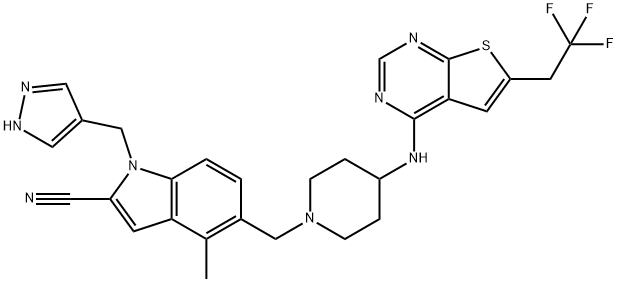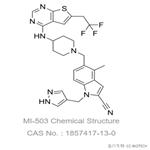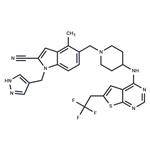MI-503 is used in the pharmacological inhibition of menin-MLL interaction that blocks progression of MLL leukemia in vivo.
MI-503 is a highly potent menin-MLL interaction inhibitor (cell-free IC50 = 14.7 nM against 1 nM FITC-MLL(4-13) peptide; cellular IC50 = 220 nM using HEK293 MLL-AF9 fusion transfectants) that targets menin MLL-binding site with high affinity (KD = 9.3 nM by ITC). MI-503 selectively inhibits mixed lineage leukemia (MLL) oncogenic fusion-driven cancer progression in cultures (GI50 from 250 to 570 nM; GI50 >5 μM against cells without MLL gene translocation) and is efficacious against human MLL leukemia MV4; tumor growth in mice in vivo (by 80-100%; 60 mg/kg/day i.p.) with good pharmacokinetic properties, oral bioavailability (73% post 30 mg/kg p.o.), and no adverse effects to the animals.
MI-503 occupies the F9 and P13 pockets on menin, forming a hydrogen bond with Tyr276, and also extends beyond the P13 pocket to form hydrogen bonds with Trp341 and Glu366. Treatment of murine bone marrow cells (BMC) transformed with the mLL-AF9 oncogene with MI-503 results in substantial growth inhibition, with GI50 of 0.22 μM. The cell growth inhibitory effect of MI-503 is time-dependent, with a pronounced impact achieved after 7-10 days of treatment.
MI-503 achieves a high level in peripheral blood following a single intravenous or oral dose while also showing high oral bioavailability (75%). MI-503 induces strong tumor growth inhibition with once-daily intraperitoneal (i.p.) administration. Treatment with MI-503 results in an over 80% reduction in MV4, 11 tumor volume, and complete tumor regression in two mice. Ten consecutive days of treatment with MI-503 results in a marked delay in the progression of mLL leukemia in mice and significantly reduces leukemia tumor burden. Treatment with MI-503 and MI-463 leads to markedly reduced expression of Hoxa9 and Meis1, downstream targets of mLL fusion proteins substantially upregulated in mLL leukemias.


